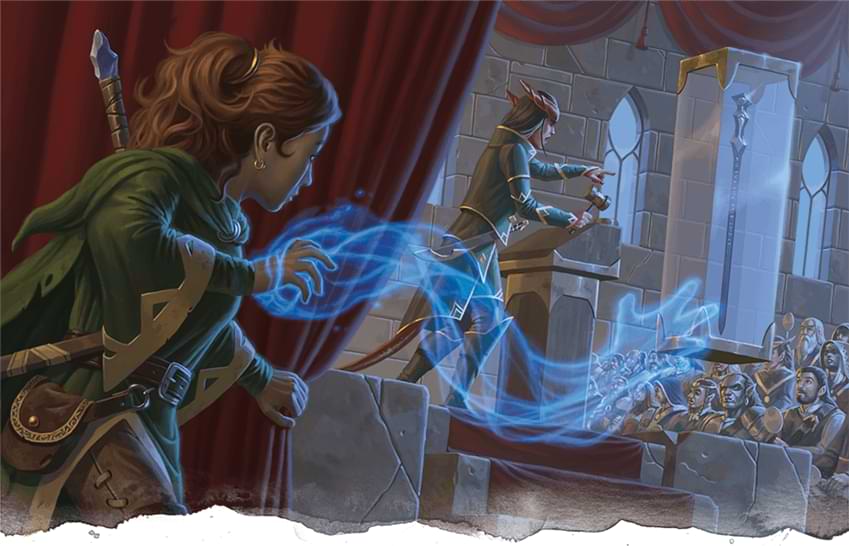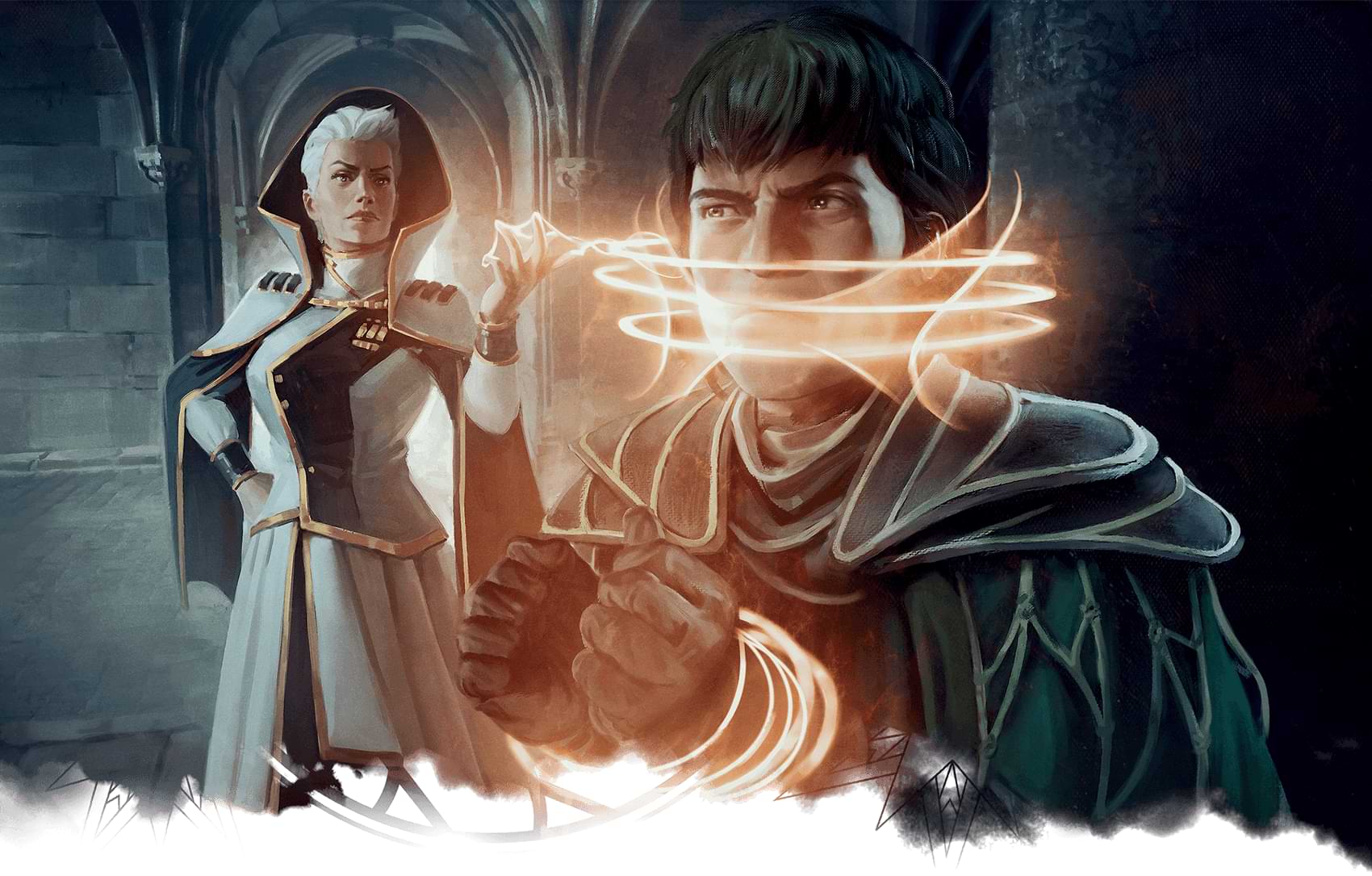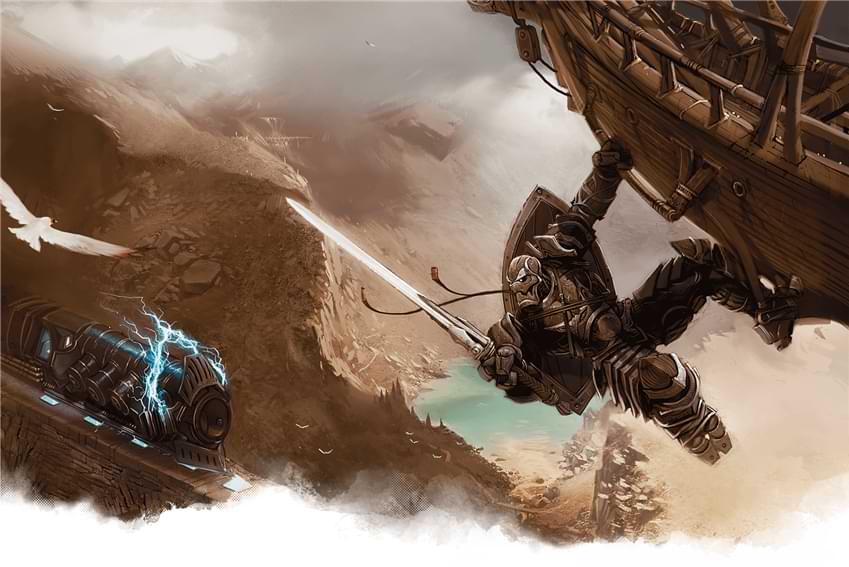When first delving into the heist genre, a Dungeon Master may be tempted to get caught up in uncrackable safes, unexpected double crosses, and Catherine Zeta Jonesing through magic laser grids. But the most important aspect of the heist genre is quite simple: tension. Tension is the lifeblood of any good heist. When running your first heist encounter, you don’t need to over prepare to keep your players on the edge of their seats.
Here are a few easy ways to sow tension when running your heist adventure.
Want Some Heists for Your D&D Campaign?
Keys from the Golden Vault contains 13 heist-based adventures ranging from levels 1-11. Collect both a physical copy of these exhilarating heist adventures, as well as a D&D Beyond digital copy when you pick up the specially priced physical + digital bundle!
Why Use Tension in Heist Adventures?

Heists are, at their core, underdog stories. They’re about those without power stealing from those with power. Tension is how you remind your players that they are the underdogs and there will be dire consequences if they get caught or fail to secure their payload. This is no mere dungeon crawl. If your players could easily brute force their way to a treasure, steal it, and make their getaway without any consequences, they would! But usually, they can’t, and that’s why they’re carrying out a heist. Tension is the narrative guardrail that inspires your players to use their brains, not their brawn.
How to Add Tension to Your Heist
When adding tension to your heist, subtlety is key. Your players' imagination will do most of the work, all they need is a little push. Think about the beginning, middle, and end phases of planning and executing a heist, and pick the right moments to introduce tension for your players.
Heist's Tension
| d12 | Tension |
| 1 | A Paranoid Patron |
| 2 | Listen to Your Players |
| 3 | Use Uncertainty as a Tool |
| 4 | Hidden Guards |
| 5 | The Hidden Boss Monster |
| 6 | A Ticking Clock |
| 7 | Witnesses |
| 8 | A Deadly Shortcut |
| 9 | Split the Party |
| 10 | Stress Tests |
| 11 | Dangerous Payload |
| 12 | Complex Traps |
1. A Paranoid Patron

The “generous benefactor” that’s hired your party is watching their every move. Have you ever tried to work with your boss looking over your shoulder? That’s the sort of unease you’re employing.
The players need to know the patron can monitor them in order for this to add tension to the adventure. Maybe it's an arrangement the party enters willingly, maybe not. Either way, they’d be smart to mind their Ps and Qs and keep chatter about betraying their patron to a minimum.
Examples:
- The group patron wasn’t kidding when she said she’d keep an eye on them. As they begin their mission, they find their patron stays close by and monitors them with arcane eye.
- A group patron has collected a strand of hair, fingernail, or drop of blood from one or more of the party. At any point in time, ask your players to make a Wisdom saving throw. If they fail, the party’s paranoid patron watches their every move via scrying.
2. Listen to Your Players
Pay attention to what details your players are hung up on in game and tug on those details to direct, or misdirect, their attention. Pointing out a single, seemingly superficial, detail can easily make your players question their surroundings. Even if these details are superficial and don’t portend danger, your party doesn’t have to know that (tee hee).
Examples:
- You notice your artificer is constantly on the lookout for traps, rolling for Investigation every chance they get. So point out a dubious, but ultimately mundane, creak in the floorboard as they enter a room. Sometimes a creak is just a creak, but maybe your artificer wants to tear up the floorboards just to be safe…
- The bard in your party is weary of a particular guard that knows their face. Have that guard Mr. Magoo their way around the party as they maneuver around him unseen.
3. Use Uncertainty as a Tool
You are not required to tell your players if their Stealth check was successful. If they rolled well, but not well enough to fool the guards, you can always say “you believe you are well hidden.” Stealth and invisibility don't make you immune to being perceived, they just make you harder to spot. Remind your players of that often, and you’ll never have a dull moment while they skulk about your scenes.
Examples:
- The rogue rolls a successful Stealth check while hiding from a guard, but the guard stops walking for a moment, like he just saw something out of the corner of his eye. He calls out, “Hello? Is anyone there?” When he’s met with silence, he mumbles and trots off, leaving the rogue uncertain if they were seen or not.
- A charming charlatan sorcerer is asked by a nobleman to dance at a masquerade ball, while her crew robs him blind. While they dance, the nobleman asks her pointed questions about herself, forcing her to tell one lie after another. The dance ends, and the nobleman departs after saying, “Until we meet again,” making her wonder whether he knows who she is.
4. Hidden Guards
Make your magic users regret sleeping on see invisibility by employing a few invisible guards who do nothing but watch. These guards act more like spies than traditional guards, choosing not to engage in combat unless provoked. They just sit in plain sight, telepathically reporting anything suspicious they see or hear. And if you really want to raise the stakes, maybe some of these invisible guards can use detect thoughts to magically scan the surface thoughts of everyone in the room.
If your player characters know about these invisible, mind-reading guards ahead of time, they could try to seek out a ring of mind shielding. Or else they may have to carry out their elaborate heist while keeping their own thoughts in check.
Examples:
- As your party investigates the casino they’re about to rob, the nervous transmutation wizard sweats under his fake beard and mustache as he looks for the backroom entrance while mentally repeating, “I’m Hogarth Hogarben, I’m from Neverwinter, and I’m here to gamble,” over and over again.
5. The Hidden Boss Monster
A single, lowly guard may not command much fear from a seasoned D&D player, but what if there was a chance that the guard was actually a deadly NPC in disguise? Suddenly, every guard they see has the potential to be a threat, pushing your players to rely more on their wits rather than blasting and smashing their way to a vault.
You don’t have to know exactly which guard is the hidden boss. It could be decided by the roll of a d10 every time the party is in the same scene as a guard. If you roll a 10, one of them is the hidden boss.
Examples:
- Desperate to catch the thieves who stole from him before, an archmage magically disguises himself as one of his inept guards.
- The guard out front, the butler down the hall, the drunk party go-er who keeps bumping into you, they were all the same person; a changeling assassin is following your every move, learning everything they can about you before striking out of nowhere.
6. A Ticking Clock
Is there anything more terrifying in D&D than a DM taking out an hourglass and turning it upside down? Giving your party a time limit, either in or out of game, to accomplish a task is an excellent way to turn up the heat. It ensures your players don’t spend three hours overplanning and debating every decision. It firmly plants your players in the moment, because every second counts.
7. Witnesses
Fill the scene with potential witnesses. Not just guards and staff, but innocent bystanders who’d earnestly tell the city watch who and what they saw last night if asked. Adding innocent bystanders also creates interesting interpersonal tension between player characters. Some may have no qualms with hurting or intimidating a witness, but that may be a hard line other party members refuse to cross.
8. A Deadly Shortcut

How much is your party willing to risk for the thrill of a big score? You can find out by giving them access to an item, or knowledge, that will help them on their mission, but at a steep cost.
Example:
- Only creatures attuned to a band of loyalty are allowed within the guards and wards on the 3rd floor, where the safe is located. As long as none of your party members drop to zero hit points while attuned to the rings, they have nothing to worry about. And for no particular reason at all, here’s the banshee stat block…
9. Split The Party
While teamwork can make the dream work, splitting the party can spawn a difficult situation if it means one group is without a healer or a tank. But even if the party is split, the two groups can still coordinate and communicate, magically if need be. Some player character abilities can easily mitigate the worst drawbacks of splitting the party, and savvy players will exploit said abilities if allowed.
An easy way to raise the stakes when splitting the party is to interrupt their communication methods. For example, If one half wandered into an area warded with silence and nondetection, they’d be completely cut off from divination spells like sending or clairvoyance, and unable to speak verbal components.
10. Stress Tests
To pull off a heist, you need to have nerves of steel. To test the resolve of your players, you could try implementing the Stress mechanic from Van Richten’s Guide to Ravenloft, but reflavored for the heist genre.
Things that could build stress during a heist:
- Failing a thieves' tools check to pick a lock
- Failing a Stealth check to hide from a guard
- Tripping an alarm
- Surviving a symbol spell
- Choosing the correct jeweled chalice to steal from the vault, and not one of the four identical decoys
- Receiving a cryptic message directed at the party (i.e., “I see you.”)
- Coming face to face with the person you’re attempting to steal from
11. Dangerous Payload
The item your players are stealing turns out to be far more dangerous than they were led to believe. Stealing the loot was one thing, getting it out will be another matter entirely. The characters have endured a lot to get to this moment, they’ll do whatever it takes to get the job done. This is a great time to introduce an unforeseen wrinkle in the plan and see how your player characters react and adapt.
Examples:
- The large, heavy chest your party must steal contains an extradimensional space. Unless your party wants to get unceremoniously sucked into the Astral Plane, they’ll have to forgo stowing it in their bag of holding or portable hole, and carry it out by hand somehow.
- When making your payload dangerous, the most insidious option is for the payload to be a sentient magic item. Try making off with an ancient artifact that wants to be found and will do anything it can to ensure it gets back to its rightful owner.
12. Complex Traps
Valuable goods usually have some sort of security system. If you're going to be stealing from a wizard or particularly paranoid noble, the traps could be elaborate and complicated to disarm, requiring the entire party to work together while also having to sneak past guards.
Example:
- Xanathar's Guide to Everything has examples of some complex traps you can use in your game, as well as some tips for making your own.
Don’t Overthink It
The big difference between a heist and your typical dungeon crawl is that your players have to know, in their bones, that they cannot win by using brute force alone. Just like the adventures in Keys from the Golden Vault, players will have to use their wits to succeed. You don’t need to craft multilayered schemes within schemes and room after room of guards to accomplish that, you just need tension. And maybe a little Catherine Zeta Jonesing through laser grids.
Kyle Shire (@kyleshire) is a contributing writer to D&D Beyond and a producer for Critical Role. In the past, he worked as a producer, writer, and host for Machinima Studios and Warner Brothers Interactive Entertainment. He's appeared on HyperRPG as the Mayor of Kollok and the Saving Throw Show. He currently lives in Los Angeles.








-
View User Profile
-
Send Message
Posted Feb 4, 2023This is cool as hell, Kyle. Thanks for this great advice!
-
View User Profile
-
Send Message
Posted Feb 4, 2023Yeah, it is actually some good advice.
-
View User Profile
-
Send Message
Posted Feb 4, 2023This is really great advice for DMs, and could probably be used to homebrew a little extra spice into the heist adventures in Keys from the Golden Vault.
-
View User Profile
-
Send Message
Posted Feb 4, 2023The idea with the Band of Loyalty and the Banshee is absolutely evil....I LOVE IT!
-
View User Profile
-
Send Message
Posted Feb 4, 2023I like the idea of the secret chest + bag of holding = astral plane problem. Of course, if they've truly done their homework, they could have someone standing by in the Astral plane, on a spelljammer ship, ready to come to the person and the chest. Granted, you do have to be able to track where they both are, so that requires some sort of signalling spell or item as s tracking beacon, or communication spells, to account for the random location issue.
-
View User Profile
-
Send Message
Posted Feb 4, 2023When it comes to heisting, I like to borrow some of the mechanics from Blades in the Dark, which is pretty much all heisting in various forms; so for a ticking clock I'd consider using the "clocks" that they use, basically a segmented circle where each time a mishap occurs the DM marks off one or more segments, pushing it closer to some outcome like the guards being alerted, a key target being locked down etc. This works better than a real-time clock which will clash with how slow certain actions in D&D can be, but a DM can still fill a segment if they feel players are wasting time.
For stress I'd also be tempted to borrow how BitD does that as well but combine with Van Richten's (stress is a penalty to rolls); I actually made a feat (with spell) that enables a similar "flashback" mechanic where a character conveniently "remembers" they were prepared all along, but you could tie its use to gaining points of stress Van Richten's style (each point is a penalty to rolls) after the first time, so the more the players have to rewrite history to proceed, the more stressed they're going to get. It's a really great mechanic in BitD though as it lets you skip a lot of the tedium of planning a heist and just get straight into the action.
-
View User Profile
-
Send Message
Posted Feb 4, 2023this would require have spelljamming in your campaign, which most people do not use. Although a spelljamming heist campaign would be cool.
-
View User Profile
-
Send Message
Posted Feb 5, 2023At very least, it'd require Plane Shift. So for a Tier-1 adventure, probably not happening. For a Tier-3 adventure, sure.
-
View User Profile
-
Send Message
Posted Feb 7, 2023Man I could snip this and use this as an OGL meme
-
View User Profile
-
Send Message
Posted Feb 7, 2023Amazing advice! Thank you for this!
-
View User Profile
-
Send Message
Posted Feb 7, 2023which part, exactly?
-
View User Profile
-
Send Message
Posted Feb 8, 2023Great article! Lots of stuff that's easy to apply. Thanks!
-
View User Profile
-
Send Message
Posted Feb 10, 2023"12 ways to add tension to D&D heists"
-
View User Profile
-
Send Message
Posted Feb 10, 2023"The bard in your party is weary of a particular guard that knows their face."
Should be wary, not weary. Good list. Trying to make off with a sentient item that wants to be found gave me some ideas.
-
View User Profile
-
Send Message
Posted Feb 10, 2023Could be weary; maybe they're so sick of this particular guard they can't be trusted not to prank and/or attack them?
-
View User Profile
-
Send Message
Posted Feb 10, 2023Banshees can easily reduce you to 0 hit points easily, with a Band of Loyalty you die if you are reduced to 0 hit points as, per its description it is meant to ensure you, as an agent, cannot be taken alive and potentially coerced into surrendering information.